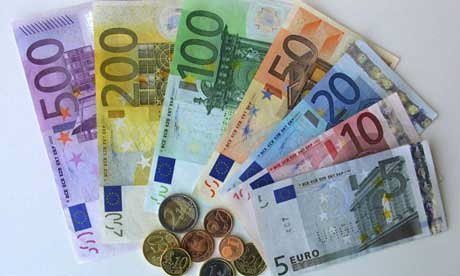
Maybe, just maybe, the bedraggled euro finally will pick itself off the floor. That’s what you hear from its champions, who rub their hands over a slowing economy in the U.S. Sadly for them, the Continent’s new common currency has as little chance of achieving lasting parity with the dollar as McDonald’s has of getting a four-star Michelin rating.
Why? The Europeans and many members of the financial press corps remain befuddled about the reason the euro is in the tank. Economics 101 provides an answer. In today’s world of liberalized capital flows, capital is sucked out of countries with relatively low returns and flows into the countries where the return is relatively high. It’s simple.
Shortly after the euro’s launch on Jan. 1, 1999, I presented a paper at a colloquium in Divonne, France, organized by the Foundation for European Civilization. My thesis: The euro would be a weak currency. This shocked the distinguished audience, which included Christian Noyer, vice president of the European Central Bank.
After all, the euro had started out at $1.17 and was only slightly down (to $1.10) from its inaugural level. Yet I remained convinced that the euro would drop to 80 cents. By the time I penned “Euroflop” for this column (Dec. 27, 1999), the euro had fallen to $1.01. Currently, the drooping euro, after repeated interventions by the ECB to prop it up, is worth 86 cents, slightly above its alltime low.
The U.S. has been deregulating and freeing up its economy for the past 25 years. This has enhanced the rate of return on capital relative to Euroland. No surprise: The U.S. has been the destination for a lot of footloose European funds—a trend that has been around long before the euro was born. To make investments in the U.S., Europeans have had to sell their European currencies and buy dollars.
No, to say this isn’t to indulge in American chest-beating. The painstaking green-eyeshade work of Anthony Norfield and his team at the ABN AMRO Bank in London bears me out. They estimated the size of the total stock of capital in the U.S. and Euroland. Then they estimated the gross operating profit (defined as earnings before interest, taxes and depreciation) in both locations and computed the rates of return on capital. Relative returns in the U.S. have been higher than in Europe’s welfare states for a long time because of the free-market system in the U.S. And the gap between U.S. and European returns has widened from 2.1% in 1998 to 2.6% today.
Deregulation takes time to work its wonders but the results are noticeable in the U.S. Don’t blame those satanic speculators pushing hot money around for the transatlantic tilt westward. Conservative European investors looking for relatively good long-term returns are the perpetrators.
Euro boosters argue that this gap won’t last long because the euro is undervalued vis-à-vis its purchasing power. But in a floating exchange rate world with free capital flows, purchasing power and other measures of a currency’s so-called fundamental value are nearly meaningless. Just look at the poor Canadian dollar. It has been “undervalued” against the greenback for years, again because Canada’s European-style welfare state has pushed investment capital south.
What next for the euro? The answer is axiomatic. As long as the U.S. stays more free-market than Europe, the euro will continue on its downward trend against the dollar.
Sure, with our economy slowing, estimates of expected operating profits are coming down in the U.S. What europhiles fail to recognize is that a slowdown is under way in Europe, too, and expected operating profits are falling. Given the fuzzy nature of profit estimates, nobody knows if profits will fall faster in the U.S. or in Euroland. This explains why the speculators remain on the sidelines.
While the trend has proven to be your friend in the long term, dollar versus euro, now is a time for caution. The short run is truly too fuzzy to merit a strong call one way or the other. Keep your eye on estimates for profits here and in Europe. If expected profits in the U.S. fall more rapidly than in Europe, the euro could get a short-term bounce. But long term? Not likely.
Author Steve H. Hanke

0 responses on "The Euro’s Rebound?"